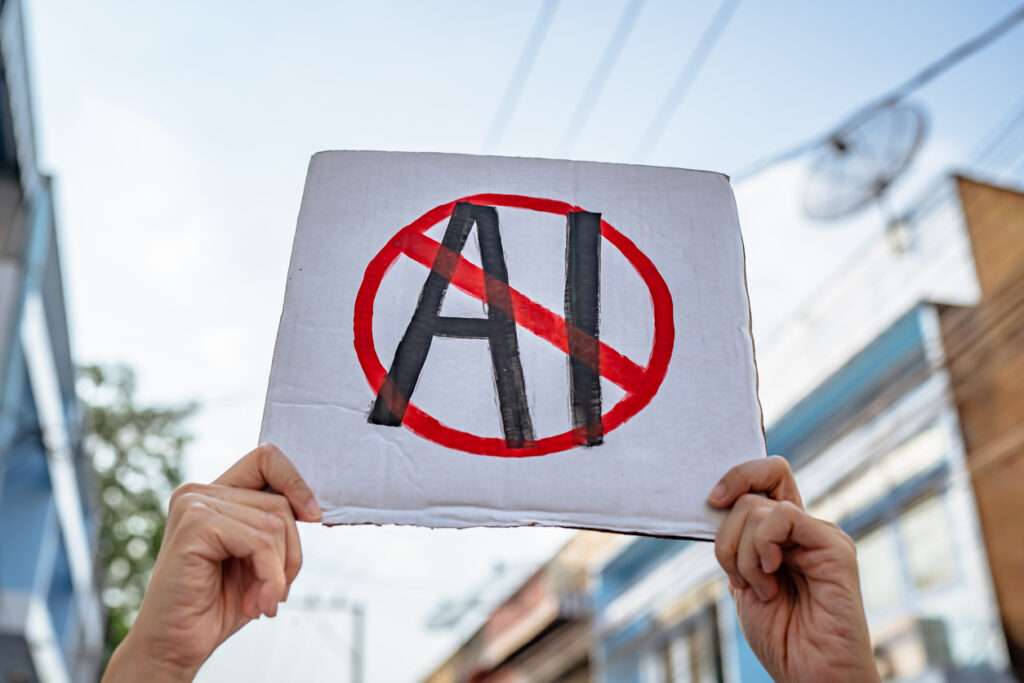Welcome to the parade of panic and progress that is the history of writing technology. Complaints about “AI slop” might feel modern, but every generation of writers, teachers, and publishers has found something to worry about when a new tool lands on their desk. The history of writing technology is a story of invention, resistance, and eventual acceptance. Let’s take a tour, with stops at the great copier and calculator controversies along the way.
The Typewriter: Civilization at Risk or Just Better Handwriting?

The history of writing technology shifted dramatically with the arrival of the typewriter. When typewriters first appeared in offices and newsrooms, penmanship teachers and etiquette experts sounded the alarm. Typing, they argued, would destroy the art of handwriting and drain personality from every page. Manual typewriters, with their heavy keys and clacking sounds, became symbols of both progress and anxiety. Mark Twain, known for his curiosity, is widely credited as one of the first major authors to submit a typewritten manuscript. That move, involving “Life on the Mississippi,” had more than a few literary purists reaching for their smelling salts (Wikipedia – Typewriter).
Yet, typed pages were easier to read. Businesses, publishers, and anyone tired of deciphering bad handwriting soon embraced the change. The panic faded, and the typewriter became the new standard in the history of writing technology.
The Photocopier: Freedom, Chaos, and Copyright Woes
No review of the history of writing technology would be complete without the photocopier. In 1976, Time Magazine asked, “What Hath Xerox Wrought?” That question led to national conversations about the risks and benefits of widespread copying. In the United States, the photocopier helped whistleblowers share secrets, making information accessible in ways that alarmed the government and many business leaders. The Soviet Union responded with strict controls on copying, but American offices buzzed with new possibilities.
Professors started building custom anthologies for students by copying articles and stories, which infuriated publishers and writers who depended on royalties. Scientific publishers worried their journals would become unsustainable. Libraries and copyright owners fought in court over fair use, with a 1968 lawsuit and changes to the Copyright Act in 1976 helping to define new rules for copying. The arrival of the internet in the 1980s soon made photocopier fears seem almost quaint by comparison (NewArt.Press summary). The photocopier left a lasting mark on the history of writing technology by changing how information spread.
The Electric Typewriter: Faster, Easier, Still Controversial

Another turning point in the history of writing technology came with the electric typewriter. Suddenly typing wasn’t such a wrist workout. Secretaries and clerical staff welcomed the relief, while some managers held onto a manual typewriter just in case everything went haywire. This shift was more than just an upgrade in equipment. It marked a major change in office life, especially for women.
I remember visiting my mom’s job at a small insurance company. Walking into her office, I’d see row after row of women at their desks, each one locked in a steady rhythm with her electric typewriter. The air was filled with the constant hum and click of keys, an oddly comforting soundtrack to a workday. Even as a kid, I could tell this was serious business, and there was a real pride in doing it well. The new machines were a step up from the old manuals my mom used to talk about, but the concentration and energy in that room belonged entirely to the people at the keys. This is a memory woven into my personal history of writing technology.
Calculators: From Outlawed to Obligatory
Calculators brought their own storm of controversy and became a milestone in the history of writing technology. When handheld calculators appeared in the 1970s, many teachers and parents worried that students would lose their math skills and just lean on the machines for every answer. Schools couldn’t agree on what to do. Some banned calculators completely, while others made them required for exams. The College Board kept changing its mind until calculators finally became standard for the SAT and most math classes (Hack Education).
I remember when I was in high school, calculators weren’t allowed at all. In college, they became an option, but not a requirement. Fast forward to when my own kids went through school, calculators were a must-have. Buying a new calculator became a back-to-school ritual. If last year’s calculator still worked and met the school’s requirements, you would keep on using it.
As calculators became part of everyday classroom life, the conversation shifted to questions of fairness. The fancier the calculator, the more of an edge it gave on tests, especially for students whose parents could afford the latest models. Eventually, calculators became just another school supply and teaching changed to fit the new reality. This episode perfectly illustrates the adaptation cycle in the history of writing technology.
Word Processing: More Pages, New Headaches

With the arrival of word processors, the history of writing technology entered the digital age. Writers could edit, reorganize, and fix mistakes with much less hassle. Software like WordPerfect and Microsoft Word soon replaced typewriters and correction tape. Teachers and editors found themselves buried under manuscripts in every imaginable font and layout. Some people worried that all this convenience would make students lazy about revising their work. Once computers became common in homes, the big question was no longer whether to allow them but how to use them most effectively (Wikipedia – Word processor).
Early word processing software made writing a lot easier and more flexible than any typewriter ever could, but it was hardly flawless. I still remember how long it took to add a single image to a WordPerfect 5.1 document. Yes, I really am that old. There was also the fun of running out of DOS memory halfway through editing a big file. Despite these headaches, I never saw anyone give up and haul their old IBM Selectric out of the closet. Once people made the leap to computers, there was no going back. This era reshaped the history of writing technology for good.
Self-Publishing: The Gatekeepers Lose Their Grip
The digital revolution made it possible for anyone to publish a book, which represents another leap in the history of writing technology. With print-on-demand and self-publishing platforms, new authors bypassed traditional publishers and took their work directly to readers. Amanda Hocking, for example, sold more than a million books as an indie author, prompting old-guard critics to complain about quality and market “flooding.” Yet readers found new voices and more choices than ever.
AI Slop: The Latest Panic in the History of Writing Technology
Today, artificial intelligence can churn out everything from essays to business emails, college application letters, short stories, and even full-length novels in just a few seconds. Editors and teachers now find themselves playing a kind of whack-a-mole, sorting through piles of assignments and submissions for writing that feels suspiciously generic, oddly phrased, or simply “off.” The term “AI slop” has become shorthand for this sort of bland, machine-made text that floods inboxes and slush piles (The New Yorker, 2025, TechCrunch – AI Slop).
Many schools are scrambling to keep things authentic by banning AI outright, doubling down on in-class essays, or bringing back oral exams. Others have moved in the opposite direction, experimenting with AI as a study partner or a brainstorming assistant. Some professors even ask students to critique or fact-check AI-generated drafts to teach research skills and skepticism. For every stern warning about the “death of creativity,” there’s a teacher or student quietly figuring out how to make the most of a new set of tools.
This latest chapter in the history of writing technology isn’t really about the machine; it’s about how people adapt, protest, and eventually find a new normal. We have seen this movie before, whether it was the panic over calculators in math class, the uproar over photocopiers, or the switch from typewriters to computers. At first, the focus is on what’s being lost. Sooner or later, though, the conversation turns to what new possibilities are opening up.
If all these debates make you wonder whether any of it truly matters—or if, in the end, what’s most important is simply the story itself—stick around. That’s exactly the question I’ll tackle in my next article.
What the History of Writing Technology Really Shows
Every stage in the history of writing technology sparks resistance and nostalgia for what came before. Over time, the new tool wins out, and the cycle repeats with the next wave. Tools may change, but people keep writing, reading, and worrying. The history of writing technology proves that as much as things change, the human urge to create and communicate remains.
Further Reading
-
Typewriter – Wikipedia
History and social impact of the typewriter. -
Electric typewriter – Wikipedia
How electric typewriters changed office work. -
Word processor – Wikipedia
The shift from mechanical to digital writing tools. - What Hath Xerox Wrought – New Art Press
The revolutionary—and controversial—impact of the photocopier. -
Calculators – Hack Education
From banned to required: how calculators changed the classroom. - The End of the English Paper – The New Yorker (2025)
AI’s impact on student writing and teaching in higher education. -
Is Technology Helping or Hurting Our Writing? – Kill Zone Blog (2025)
A writer’s nostalgic, humorous take on how every new tech is met with skepticism.
Technology keeps moving, the anxieties keep coming, and the writing keeps happening—one upgrade at a time.
Connect with the Author
Curious about the inspiration behind The Unmaking of America or want to follow the latest news and insights from J.T. Mercer? Dive deeper and stay connected through the links below:
-
About the Author
Discover more about J.T. Mercer’s background, writing journey, and the real-world events that inspired The Unmaking of America. Learn what drives the storytelling and how this trilogy came to life. -
NRP Dispatch Blog
Stay informed with the NRP Dispatch blog, where you’ll find author updates, behind-the-scenes commentary, and thought-provoking articles on current events, democracy, and the writing process.
Whether you’re interested in the creative process, want to engage with fellow readers, or simply want the latest updates, these resources are the best way to stay in touch with the world of The Unmaking of America and beyond.
Free Chapter
Begin reading The Unmaking of America today and experience a story that asks: What remains when the rules are gone, and who will stand up when it matters most? Join the Fall of America mailing list below to receive the first chapter of The Unmaking of America for free and stay connected for updates, bonus material, and author news.

